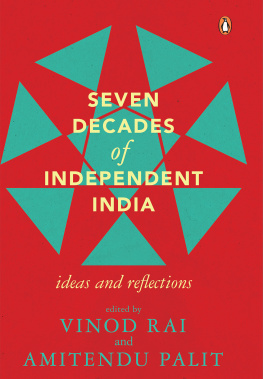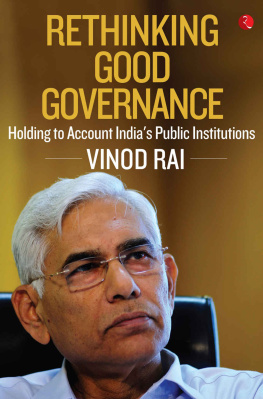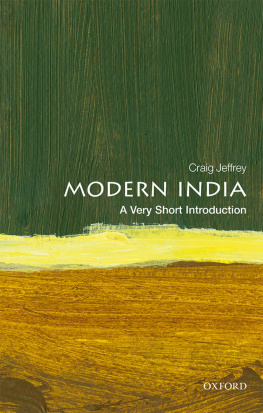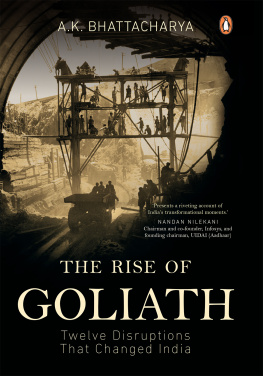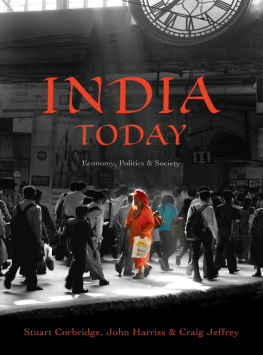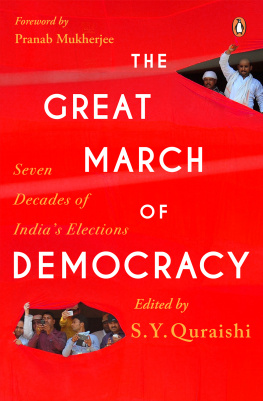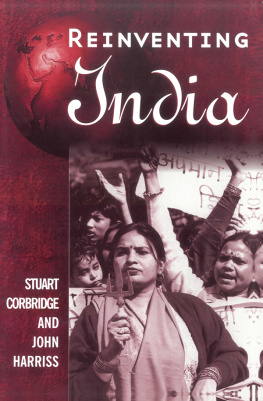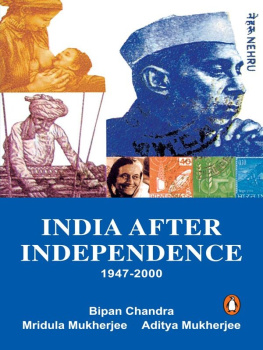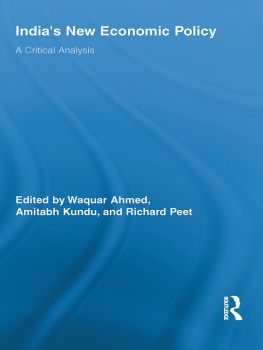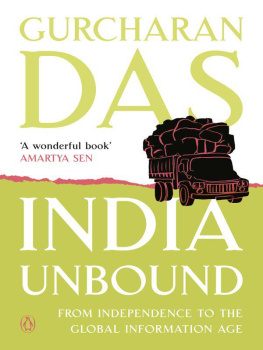Vinod Rai - Seven Decades of Independent India
Here you can read online Vinod Rai - Seven Decades of Independent India full text of the book (entire story) in english for free. Download pdf and epub, get meaning, cover and reviews about this ebook. year: 2018, publisher: viking, genre: Politics. Description of the work, (preface) as well as reviews are available. Best literature library LitArk.com created for fans of good reading and offers a wide selection of genres:
Romance novel
Science fiction
Adventure
Detective
Science
History
Home and family
Prose
Art
Politics
Computer
Non-fiction
Religion
Business
Children
Humor
Choose a favorite category and find really read worthwhile books. Enjoy immersion in the world of imagination, feel the emotions of the characters or learn something new for yourself, make an fascinating discovery.
- Book:Seven Decades of Independent India
- Author:
- Publisher:viking
- Genre:
- Year:2018
- Rating:4 / 5
- Favourites:Add to favourites
- Your mark:
- 80
- 1
- 2
- 3
- 4
- 5
Seven Decades of Independent India: summary, description and annotation
We offer to read an annotation, description, summary or preface (depends on what the author of the book "Seven Decades of Independent India" wrote himself). If you haven't found the necessary information about the book — write in the comments, we will try to find it.
Vinod Rai: author's other books
Who wrote Seven Decades of Independent India? Find out the surname, the name of the author of the book and a list of all author's works by series.
Seven Decades of Independent India — read online for free the complete book (whole text) full work
Below is the text of the book, divided by pages. System saving the place of the last page read, allows you to conveniently read the book "Seven Decades of Independent India" online for free, without having to search again every time where you left off. Put a bookmark, and you can go to the page where you finished reading at any time.
Font size:
Interval:
Bookmark:



AMITENNDU PALIT

PENGUIN BOOKS

PENGUIN BOOKS
P utting together a volume on seven decades of independent India might appear a far-fetched notion given the depth and range of issues that the task would entail. As editors, therefore, we began with the assumption that however hard we tried we would not be able to do justice to the scale. Several subjects of significant importance for India would be left untouched by the book as would diverse opinions on the subjects that are included. As we pen these words, we realize the gaps that we were not successful in filling up. We hope there would be more opportunities for us to look back at India and the wonder that she is.
At the same time, we found the journey exciting and pleasant. As we went through the contributions, we realized the richness of thoughts that we have been able to gather. Rarely can one hope to achieve the unique blend of scholastic opinions with practitioner insights that the pages to follow would reveal. We feel elated at having been able to gather expertise across a vast spectrum of subjects for reflecting on how India was, is, and might be, after seventy years of its independence.
The book has deliberately been developed with a broad perspective on the subjects covered. But we had to do justice to a core theme within the broad canvas. As the reader will realize, public policies and institutions have been the implicit, if not the explicit, context of the entire book. All contributors have examined policies and their applications, notwithstanding whether they have been written on economic, social, political, external relations or governance issues. While we expect the book to generate interest among all readers given the issues it covers, we are certain about its contribution to the discourse on policies and institutions in India. Our effort has been to ensure that policy enthusiasts on India should get to consume insights and ideas from a group of experts whose views are not only much sought after, but also unique given their vast experience and knowledge on what they have written.
The idea of this book began from our conversation with Ambassador Gopinath Pillai, chairman at the Institute of South Asian Studies (ISAS) in the National University of Singapore. The book can be rightfully called an ISAS product. As research faculty of the ISAS, we would like to thank all our colleagues at ISAS for their invaluable help that we received at various points in time during the work on the book. Specifically, we would like to thank Ambassador Gopinath Pillai, Professor Subrata Mitra (director, ISAS) and Hernaikh Singh (senior associate director) for their unfailing support and encouragement at all stages. Quite a few of the contributors in the book are either with ISAS, or have been associated with it at various stages. The book is an example of the excellent scholarship and commendable expertise on India and South Asia that ISAS has cultivated over the years and the contribution that it would continue to make in this regard.
We can hardly thank the distinguished contributors of this volume enough for their time and effort. They have been most supportive, diligent and patient in all their responses and communications to our repeated queries. We cherish the experience of working with a wonderful team of authors. We have learnt a great deal from what they have written for this book and we are sure that the readers would benefit as much as we have from their writings.
As editors, we owe large debts of gratitude to some without whom this book would not have been seen the light of the day. Our colleague Faiza Saleem, research assistant at ISAS, has worked on the manuscript with precise care. Her rigour and attention has gone a very long way in giving the book its final shape. Indrani Dasgupta, copy editor at Penguin Random House India, has been prompt and detailed in scrutinizing the book as thoroughly as possible. Last, but not the least, in our list of those to whom we are deeply grateful is Lohit Jagwani, commissioning editor, Penguin Random House India. Right from the beginning, Lohit has tended the book with great affection and has spared no efforts to ensure its timely evolution and progress. Finally, like in all our other endeavours in life, this work too, would not have come to fruition without the support and encouragement of our respective better halvesGeeta and Parama. All the lapses and lacunae in the work remain entirely ours.
Vinod Rai and Amitendu Palit
P ublic policy discussions on India present formidable intellectual challenges given the great variety of issues and perceptions involved in their objective analysis. The challenges become more daunting given the expansive backdrop of a few thousand years, over which India has produced individuals and ideasAryabhata in space exploration, Chanakya in governance, emperor Akbar in religious coexistence, Ramanujan in mathematics, Gandhi in ahimsa, Tagore in humanityto name only a few. They have become examples for the world to emulate and admire. The world has kept looking at India for new sources of admiration even after Independence, notwithstanding the substantive changes in its sociopolitical and economic context.
Comprehending Indias journey over the seven decades that it has travelled since 15 August 1947 is not possible unless contextualized in the light of the pain and the trauma characterizing the milieu in which independent India took its first steps. Partition sowed seeds of hatred to a great depth among the countrys major religious communities. The animosity, which was difficult for the young country and its new leaders to contain, remains a significant challenge even today with communal harmony a major governance goal for political leaderships and administrations across the country. The importance of building a secular, independent India and making its institutions work in a fashion uninfluenced by religious tensions and biases have been a key objective of Indian public policies. Most of the public policy is shaped by the tenets of the Indian Constitution.
India chose to go down a path like most other countries at the time, which were emerging from and embarking on independent futures. Providing effective governance and building efficient institutions were major public policy challenges that India encountered upon becoming a sovereign republic. The intensities of these challenges were, in many respects, more for India than its peers given its remarkable decision to grant complete political freedom to all in the country. The grant of democratic liberty, along with a series of Constitutional rights guaranteeing freedom of speech, opinion and religious practices for individuals, wasnt accompanied by a similar freedom for economic activity. For four decades after Independence, India relied on the state as the main driver of economic growth. The seeds of state-led economic development sown in the Industrial Policy Resolution of 1956 were carried forward over the next decades into greater dominance of the public sector and contracting role of private enterprise. By then, India had nationalized its banks, insurance companies and coal mines, and regulated private capacities in heavy industries through licences. The government was steering towards reaching the overarching goals of tackling poverty, reducing unemployment and ensuring self-sufficiency in food production. The way it decided to do it was through greater state control, which then laid the foundation for a licence and inspector raj through the regulatory apparatus it spawned. In a sense, it created more governance and institutional challenges for India, primarily by generating bottlenecks in economic expansion and efficient delivery of public services, which the country could have well avoided. Most of the economic reforms that India effected since the early nineties were aimed at undoing the deeds of the past four decades. The energy and time spent in creating unproductive regulations and disbanding them were costs that the country could have well avoided.
Font size:
Interval:
Bookmark:
Similar books «Seven Decades of Independent India»
Look at similar books to Seven Decades of Independent India. We have selected literature similar in name and meaning in the hope of providing readers with more options to find new, interesting, not yet read works.
Discussion, reviews of the book Seven Decades of Independent India and just readers' own opinions. Leave your comments, write what you think about the work, its meaning or the main characters. Specify what exactly you liked and what you didn't like, and why you think so.

